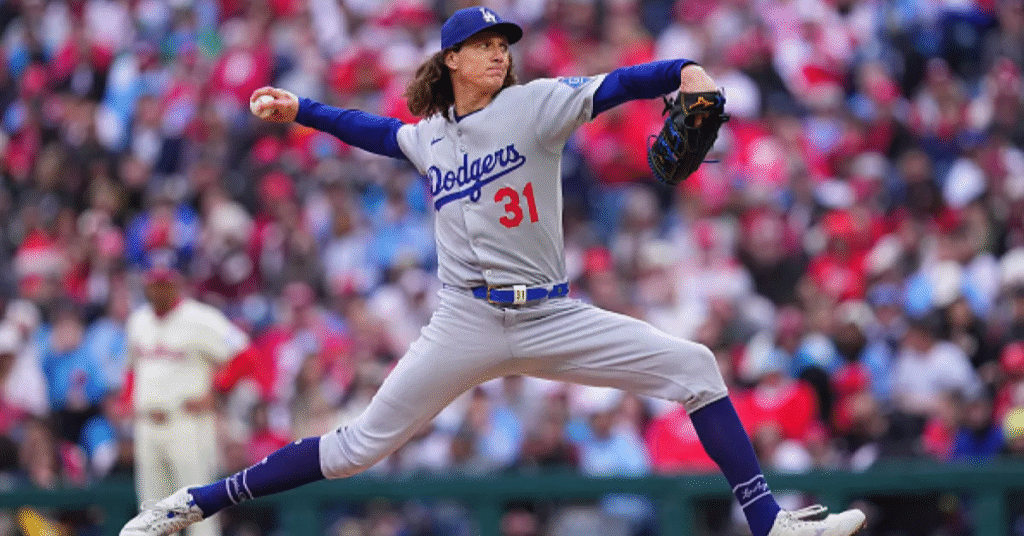The Los Angeles Dodgers, defending World Series champions, made a powerful statement in their postseason opener by dispatching the Cincinnati Reds with clinical efficiency. What was expected to be a challenging series quickly turned into a display of dominance, as the Dodgers’ deep roster and relentless pitching overwhelmed a Reds team that entered the matchup brimming with momentum. With this victory, the Dodgers now advance to the National League Division Series (NLDS), where they will face the Philadelphia Phillies—a team equally determined to prove their October credentials. For Dodgers fans and baseball analysts alike, the question now is whether this postseason machine can maintain its sharp edge against a Phillies squad that thrives on unpredictability.
At its core, this Dodgers victory over the Reds reinforced the strengths that have defined the team throughout the season: a relentless lineup, an airtight bullpen, and a rotation that bends but never breaks. The Reds, known for their offensive surges, were stymied by Dodgers pitching, and their attempts to claw back late in games fell short. For the Dodgers, however, this wasn’t just about winning—it was about sending a message that they are prepared to defend their crown, and that any opponent, regardless of form, will be forced to reckon with the depth and precision of a team built for October.
The Dodgers’ Postseason Machine: How Depth Overwhelmed the Reds
Depth has long been the Dodgers’ greatest weapon, and against Cincinnati, that truth was on full display. The lineup, from top to bottom, created pressure in every inning, forcing Reds pitchers into high-stress counts and errors of execution. What separated the Dodgers from their opponent wasn’t simply star power—it was the ability of role players to rise to the occasion. Pinch hitters contributed key hits, defensive replacements turned momentum-stopping plays, and the bullpen proved airtight in closing the door.
The Reds, in contrast, leaned heavily on a handful of star hitters, but when those bats went quiet, so too did their hopes. In a short series, that imbalance was decisive. As one Reds coach reportedly admitted post-game, “They come at you with waves. It’s not just one or two guys—it’s everyone. That’s the hardest part of playing them.”
Pitching Precision: A Blueprint for October
The Dodgers’ starting rotation delivered performances that spoke less to overpowering velocity and more to precision. Mixing breaking balls with well-timed fastballs, they disrupted Cincinnati’s timing and minimized the long-ball threat that had carried the Reds into the postseason.
In Game 1, a masterful outing by the Dodgers ace set the tone, striking out nine while walking just one. Game 2 showcased the bullpen’s collective dominance, with five relievers combining for scoreless frames. By the time Game 3 arrived, Cincinnati looked fatigued, their swings hurried, their approach desperate.
This approach—the blending of analytics, scouting, and in-game adjustments—is what the Dodgers have perfected. They don’t just throw pitches; they dismantle lineups inning by inning, pitch by pitch.
Offensive Firepower: Relentless Pressure at the Plate
While pitching may have silenced the Reds, the Dodgers’ offense put the series out of reach. Timely hits with runners in scoring position proved to be the difference, as Los Angeles executed situational hitting with textbook precision. Sacrifice flies, opposite-field singles, and patient walks painted a picture of a team unafraid to grind out runs instead of relying solely on power.
That patience wore down Cincinnati’s bullpen, forcing them to bring in arms earlier than expected, and once cracks appeared, the Dodgers capitalized. As one veteran player put it: “We trust the next guy. If I don’t get it done, I know someone else will.”
A Glimpse at the Numbers
To illustrate the series’ turning points, here’s a breakdown of performance metrics that highlight why the Dodgers prevailed.
| Category | Dodgers | Reds |
|---|---|---|
| Team Batting Average | .287 | .214 |
| Runs Scored | 19 | 7 |
| Home Runs | 6 | 2 |
| Bullpen ERA | 1.32 | 4.89 |
| Defensive Errors | 0 | 3 |
The numbers reveal more than dominance—they show a team executing on every front, from hitting to defense. The Reds’ errors further compounded their inability to sustain momentum, while the Dodgers’ discipline and consistency offered a masterclass in October baseball.
Facing the Phillies: A Clash of Contrasts
The Dodgers’ next challenge, the Philadelphia Phillies, presents a dramatically different test. While the Reds relied on bursts of offense, the Phillies are powered by a balance of elite starting pitching and a star-driven lineup that thrives in clutch situations. Philadelphia’s ace pitchers have shown the ability to shut down even the most potent lineups, and their veteran hitters bring postseason experience that rivals Los Angeles’.
In this NLDS, the matchup will hinge on how well the Dodgers’ depth can withstand the Phillies’ stars. Will the machine-like efficiency of Los Angeles wear down Philadelphia’s rotation, or will the Phillies’ big names deliver moments that shift the series? As one scout noted: “This is the heavyweight fight everyone wanted. One team wins with precision, the other with power. October decides which matters more.”
Fan Expectations and the Weight of Repeat Glory
No team in recent memory has carried the weight of expectation quite like the Dodgers. Winning one World Series is monumental; defending it requires a blend of consistency, resilience, and adaptability. Fans know that the regular season is merely a prelude; in Los Angeles, October defines everything.
For Reds supporters, there is disappointment but also hope. Reaching the postseason at all was a victory, showcasing a roster that has grown beyond rebuilding. For Phillies fans, anticipation is at a fever pitch. The chance to topple the reigning champions carries with it not only the allure of advancement but the satisfaction of measuring themselves against the best.
The Broader Context: What This Series Reveals About Modern Baseball
The Dodgers-Reds series was more than a simple result—it was a reflection of how modern baseball has evolved. Depth, versatility, and adaptability now outweigh the days when a single star could carry a team through October. Analytics have become as vital as raw talent, and organizations like the Dodgers are at the forefront of blending traditional baseball instincts with cutting-edge data.
This evolution means that teams like Cincinnati, still reliant on streaky power and star-driven bursts, must adjust or risk being left behind. Meanwhile, Philadelphia, like Los Angeles, has embraced a hybrid approach, creating a matchup in the NLDS that feels like a referendum on the future of baseball strategy.
Conclusion: A Machine Rolls On, But a True Test Awaits
The Dodgers’ dismantling of the Reds reinforced why they are World Series champions. A seamless blend of offense, pitching, and defensive excellence proved too much for an opponent that simply lacked the tools to keep pace. Yet October baseball is never about what has already been accomplished—it is about what lies ahead.
Against the Phillies, the Dodgers will need more than efficiency; they will need moments of brilliance, resilience under pressure, and the ability to adapt in the face of a worthy adversary. The Reds series was a reminder of the Dodgers’ dominance. The Phillies series will reveal whether that dominance can withstand the volatility of October.
As one commentator aptly summarized: “The Dodgers look like a machine, but even machines can be tested. The Phillies will do just that.”
FAQs
1. How did the Dodgers beat the Reds so decisively?
The Dodgers combined dominant pitching, disciplined hitting, and error-free defense to neutralize Cincinnati’s strengths and overwhelm their bullpen.
2. Why are the Dodgers referred to as a ‘machine’?
Because of their depth, consistency, and ability to execute under pressure, the Dodgers operate with mechanical precision throughout games.
3. What makes the Phillies a tougher challenge than the Reds?
The Phillies bring elite starting pitching and a veteran lineup capable of delivering clutch performances in high-stakes postseason games.
4. How significant was defense in the Dodgers’ victory?
Crucial. The Dodgers committed no errors while capitalizing on the Reds’ mistakes, preventing momentum shifts and preserving leads.
5. Can the Dodgers repeat as World Series champions?
Yes, but their toughest challenges lie ahead. The Phillies and subsequent opponents will test the depth and adaptability of the roster.







